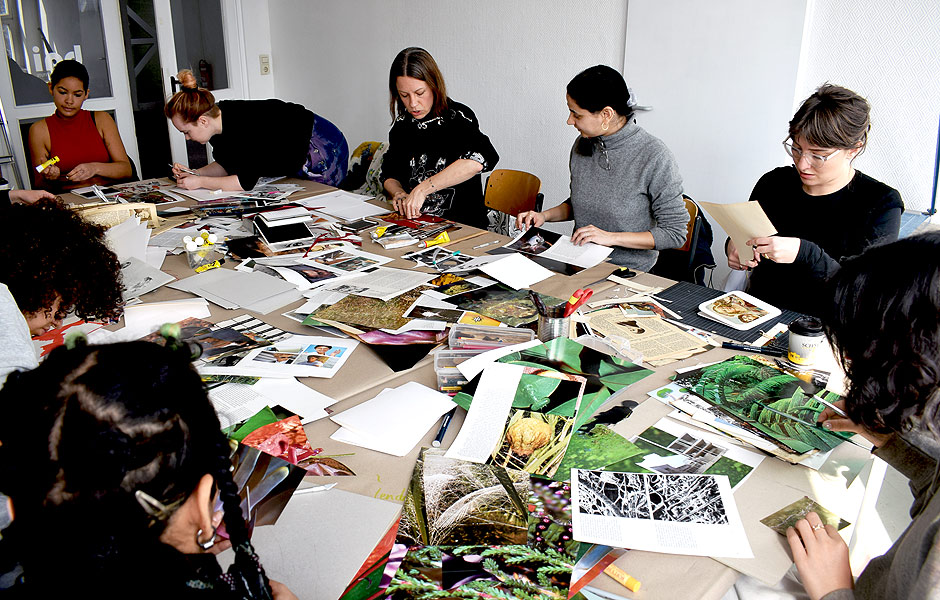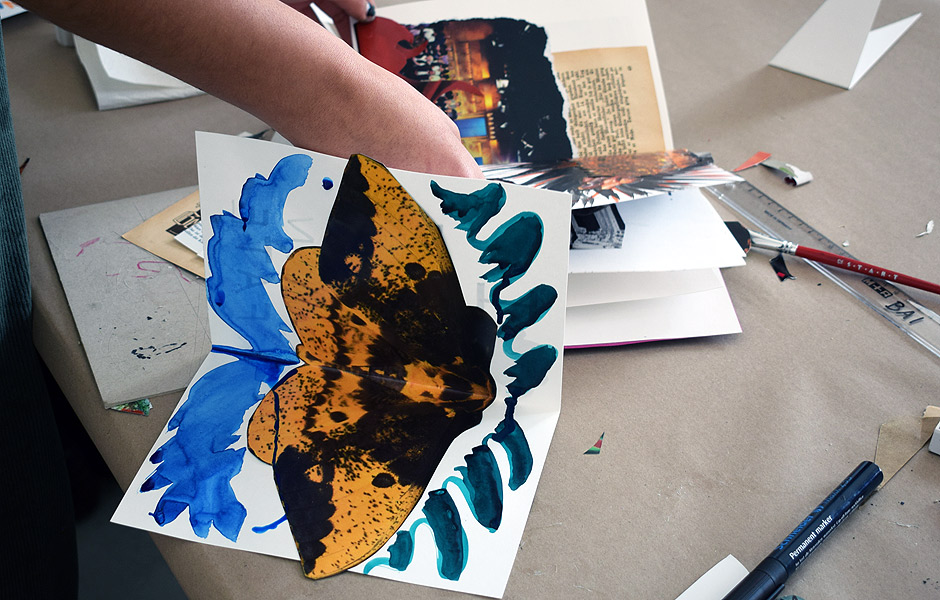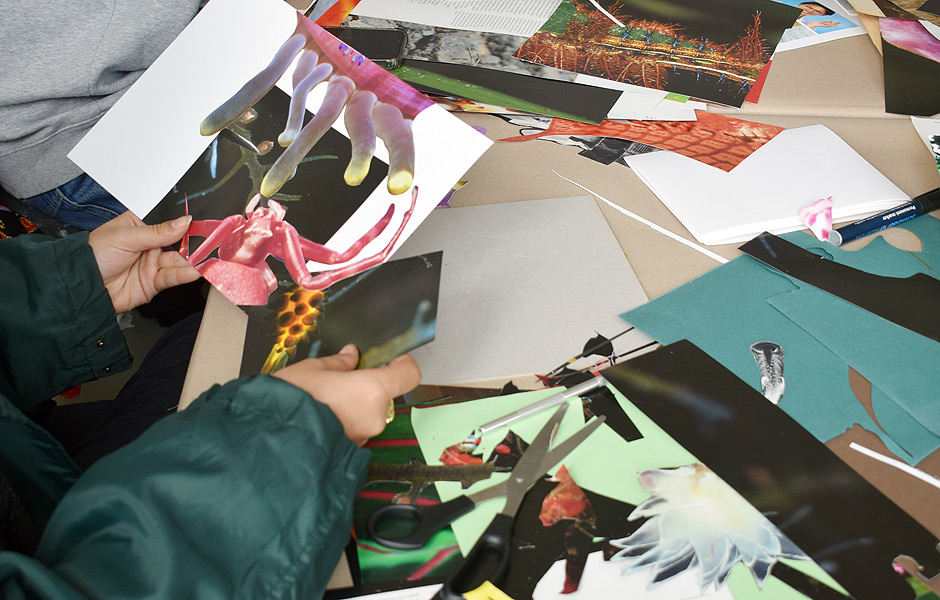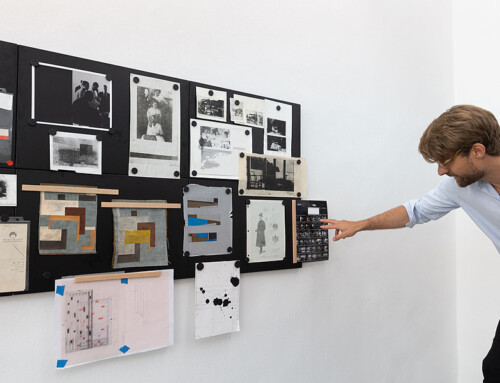Summer School Course A LIBRARY OF IDEAS: The Art and Craft of Artists’ Books by Emily Hunt
General Course Description
An artwork can take infinite forms, much like a book. When an artist merges these two – treating the book as a work of art – it creates a flexible framework that fosters autonomy, freedom, experimentation, and research. The book becomes a space for inquiry, allowing the artist to engage in writing, drawing, and material exploration while maintaining a structured yet adaptable format. It also serves as a means of circumventing institutional constraints, offering an alternative to traditional gallery systems, disseminating ideas, and producing affordable works that can reach audiences beyond conventional art spaces.
This summer school course, A LIBRARY OF IDEAS: The Art and Craft of Artists’ Books, focuses on the independent art practice of creating books as artworks. Rooted in avant-garde traditions—from the self-published books of the Dadaists and Surrealists to the Italian Futurists and Fluxus movement—this practice resists the digital, embracing the tactile and bridging historical and contemporary approaches.
Throughout the week from August 25 to 29, 2025, artists will explore a range of paper-based techniques, including monoprinting, watercolor painting, collage, and the cut-up method, culminating in the creation of their own artist’s book. (Text & photos by courtesy of Emily Hunt)
Learning Outcomes
This five-day summer school, A LIBRARY OF IDEAS: The Art and Craft of Artists’ Books focuses on connecting ideas to materials, encouraging artists to experiment with new techniques and integrate them into their own practices. The participants will explore the artist’s book as both a medium and a framework for creative expression. By being exposed to previously unknown techniques, artists can refine their skills and fold new techniques into their work.
Group discussion are key components of the course. Participants will exchange ideas, share knowledge, and engage in critical discussions that enrich their artistic approaches.
By the end of the course, artists will have completed a finished artwork, received feedback from the lecturer and peers, and worked to a set deadline. They will have expanded their practice, learned new techniques, deepened their material knowledge, and developed a strong foundation for sustaining a daily artmaking practice.
General Guidelines
This course is designed for artists of all disciplines and for anyone interested in learning new techniques from a practicing artist. It is aimed at individuals with an interest in art history and contemporary art who incorporate materials into their artistic practice. While no prior knowledge of the subject is required, participants should bring an open and engaged attitude to the subject matter and a willingness to experiment with new materials.
Benefits
- Participants will experience an intensive week that emphasises material outcomes.
- Hands-on demonstrations from a practicing artist will give participants direct exposure to new techniques, enhancing their skill development.
- Learning about new artists and references expands creative inspiration and provides a broader artistic context.
- Developing the ability to create first and evaluate later encourages a more intuitive, uninhibited creative process. ·
- The task of the artist to edit their own work for a more refined artwork.
- Lectures complement workshops, providing a balanced understanding of theory and practice.
- Exploring connections between art history and contemporary practice deepens critical understanding.
- Understanding how to develop and present a finished artwork provides practical knowledge to be taken back into the studio and exhibition environment.
Methods and Topics of Teaching
- Practical demonstrations by an experienced lecturer who provides hands-on guidance through various techniques.
- One-on-one feedback offering personalized, intensive exploration and creative development throughout the course.
- A focus on experimentation with a deadline, encouraging participants to complete their work and critically assess it at the end of the process
- Exploration of woodcut, etching, and engraving techniques in the history of printmaking during the Renaissance, along with the development of early manuscripts which set the foundation for artists’ books.
- A study of William Blake’s pioneering work in combining visual art and poetry in self-published books, influencing the future of the medium.
- The evolution of avant-garde, conceptual, and contemporary artist books, including zines and distribution methods, highlighting key movements like Dada, Fluxus, and contemporary zine culture, and how artists distribute their works outside traditional galleries.
- An in-depth look at asemic language, the cut-up method by Burroughs and Gysin, collage, and artist prints, with a focus on unconventional writing forms and the integration of collage and printmaking techniques in artist books.
- Practical exploration of watercolor techniques, paper manipulation, and binding methods that structure and enhance the finished work.
Program Structure with Daily Course Description
Day 1
9:30 AM Reception at the BAI
Morning Session: Handwriting: The Wandering Line
To commence the summer school week, Emily Hunt will present an overview of her artistic practice, highlighting her work in printmaking, collage, painting, and artist books. This presentation will provide insight into the techniques and concepts that have shaped her approach over the years.
The first lecture will focus on the significance of handwriting as a unique form of expression. Every individual possesses a distinct handwriting style, whether in everyday writing or personal signatures. The lecture will begin with a study of the earliest manuscripts produced in Europe, created in a setting known as the scriptorium. The discussion will then turn to the emergence of artists creating their own editions of artist books, with particular reference to the works of William Blake, William Morris, and Gertrude Stein. The lecture will conclude with an exploration of Asemic writing, in which the artist invents a personal language, leaving interpretation open to the viewer.
Following the lecture, the workshop will begin with a series of exercises designed to explore handwriting techniques, the creation of asemic alphabets, and the use of artistic language as an abstract form of expression.
Afternoon Session: The History of Artists making Books
In the afternoon, a visual lecture will provide an overview of the various types of artist books produced by avant-garde movements, including the Italian Futurists, Dada, and Surrealism. The lecture will then examine the development of artist books in the post-1950s, focusing on contemporary artists’ contributions to the medium.
The afternoon workshop will encourage participants to begin conceptualising their individual artist books. Artists will be guided to consider key aspects of their projects, such as whether there will be a central theme or title, whether the work will feature a narrative or be conceptual, the size of the book, and the presence of a unifying theme in the work.
Day 2
Morning Session: Chance in Creation: Aleatoricism in Text
The morning lecture will begin with a discussion on the history of the Cut-up Method and concrete poetry. The Cut-up is an aleatory narrative method wherein a written text is physically cut into fragments and reassembled to produce a new text. While its conceptual origins can be traced to the Dadaist movement of the 1920s, the technique gained prominence during the 1950s and early 1960s, most notably through the work of author William S. Burroughs and Brion Gysin.
Concrete poetry is where language meets visual art in its most experimental form. By manipulating the physical arrangement of words, letters, and shapes, concrete poets transcend traditional language use, transforming the text itself into an artwork. It’s poetry that isn’t just read—it’s seen.
The practical component of the workshop will incorporate second-hand books sourced from local flea markets in Berlin. Emily Hunt is also a passionate book collector, these books are deliberately sourced as special resources to use for this class alone.
Afternoon Session: No two unlike: the print as artwork
Keeping in mind the theme and context of each artist book, participants will begin an experimental printing session using jelly plates. Monoprinting (or monotype) is a printmaking technique where the image can only be created once, unlike traditional printmaking methods that allow for multiple originals. This “no two alike” approach will generate unique content for the participants’ artist books.
Day 3
Morning Session: Drawing with Watercolour: the spontaneous medium
Watercolour is a versatile and portable medium, requiring only a small table to work on, it allows the artist to always be working on a project. This is a medium which is suited for the “kitchen-table studio”. It is expressive, translucent, and affordable, encouraging both practice and experimentation. Its short drying time allows for layering and makes it well-suited to collage techniques.
The day will begin with an experimental workshop exploring techniques such as salt effects, background creation, layering, pattern-making, and collage. It will be an intensive session featuring seven exercises designed to culminate in finished artworks, which may be selected for inclusion in the artist’s book. Found printed matter will serve as source material, inspiring spontaneous decision-making throughout the workshop.
Afternoon Session: Paper Cuts: working with paper sculpture
The afternoon session will begin with a short visual lecture exploring paper sculpture techniques, papier-mâché, and binding decisions within the context of artist books. This presentation will highlight how paper can be manipulated beyond the flat plane—folded, layered, sculpted, and transformed into dynamic structures. We will examine historical and contemporary examples of artists who have pushed the boundaries of paper as a material, from experimental bookbinding techniques to sculptural book forms that challenge conventional formats.
The afternoon workshop will be dedicated to hands-on experimentation, focusing on techniques that expand the physicality of the artist’s book. Participants will explore papier-mâché as a method of building texture and dimensionality, sewn binding as a structural and aesthetic choice, and various craft-based approaches that support the completion of their book projects. This session will encourage an exploratory approach, where materials guide decision-making, and unexpected outcomes are embraced as part of the creative process.
Day 4
Morning Session: Collages create a Truth of their own: Using collage in Artist books
To begin the morning session, a visual lecture will be presented on the history of 20th-century collage, contemporary collage practices, and its role in artist books. This will provide a foundation for understanding how collage has been used as both a radical and intuitive means of art-making, from early avant-garde movements to its continued relevance in contemporary practice.
Following this, we will engage in a hands-on workshop, creating new collages for the artist book while also integrating and reworking artworks produced throughout the week. Collage is inherently improvisatory—an act of spontaneous composition that allows for unexpected connections between disparate elements. It functions as both a problem-solving tool and a method of disrupting conventional visual narratives. The layering of found imagery, printed matter, and personal materials generates friction, producing works that carry a host of competing meanings.
Through this process, artists will explore the materiality of paper, the tension between chance and control, and the potential for collage to act as both an archival and experimental form. This session encourages an open-ended approach, where cutting, layering, and juxtaposing elements reveal new artistic possibilities within the structure of the artist book.
Afternoon Session: Edit, cull, refine: finishing an artist book
In the afternoon session, we will bring together all the work created throughout the week, refining and shaping it into a cohesive artist’s book. This process involves a careful act of selection—choosing the strongest pieces, editing out what does not fit the overarching theme, and considering the rhythm and flow of the book as a whole. Through discussion and experimentation, we will explore different binding methods, beginning the task of resolving the artist’s book.
Day 5
Morning Session: How to talk about a book: presentations of artist books
To begin the morning, we will complete the finishing touches on each artist’s book, refining details and making final adjustments. We will then open the discussion to all participants, inviting them to reflect on the outcomes and successes of their artist books created throughout the program. This will be a session of talking about each book—an opportunity to present the work, discuss discoveries made during the process, and reflect on how these new approaches might carry forward into future practice.
Afternoon Session: Final collaboration: swapping artworks
In the afternoon, following the feedback session, we will gather artworks that were not included in each artist’s book and repurpose them into smaller zines. This process encourages a fluid, non-hierarchical approach to art-making—where nothing is wasted, and every piece finds a place. Participants will have the opportunity to swap works with one another, allowing for unexpected collaborations and new dialogues between images.
General Information
Duration: August 25 – 29, 2025
Hours: Each day from 10 AM – 4 PM (including several breaks & lunchtime)
Seats: Min: 6 | Max: 20 | Language: English
Fees: There is a one-off registration fee of €50. The participation fee is €850 per person (without accommodation).
The fee is VAT-exempt by the Governing Mayor of Berlin – Senate Chancellery Higher Education and Research pursuant to Paragraph 4 No. (21) (a)(bb) UStG (German Value Added Tax Act).
Your Summer School Instructor
Emily Hunt (born Sydney, 1981) creates ornamental, figurative ceramics. Her background as a rare-book dealer has informed her approach to art-making, drawing on a wide range of historical and visual references. She has designed workshops using materials such as silk painting, plaster, monoprinting, ceramics, and watercolor painting. Experimentation with materials is central to her practice. With over 15 years of experience as an artist, Hunt aims to foster conversation, share knowledge, and demonstrate techniques in the classroom.
Hunt was selected as a participant in the Goldrausch Künstlerinnen Projekt 2020. Her work has been exhibited at SCCA (GH), Sonneundsolche (DE), Galerie Wedding (DE), Hans Arp Museum (DE), Museum of Contemporary Art (AU), Zitadelle Spandau Museum (DE) Sim Smith Gallery (GB) Te Uru Waitakere Gallery (NZ) Monopol Galerie (PL) and the Art Gallery of New South Wales (AU).
More information on the Emily Hunt Website and on Instagram.






